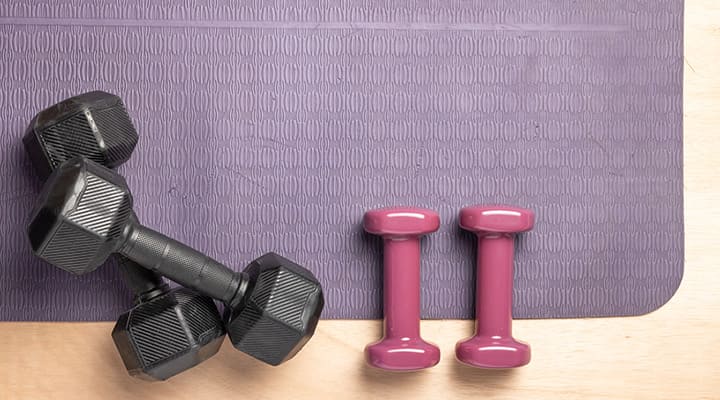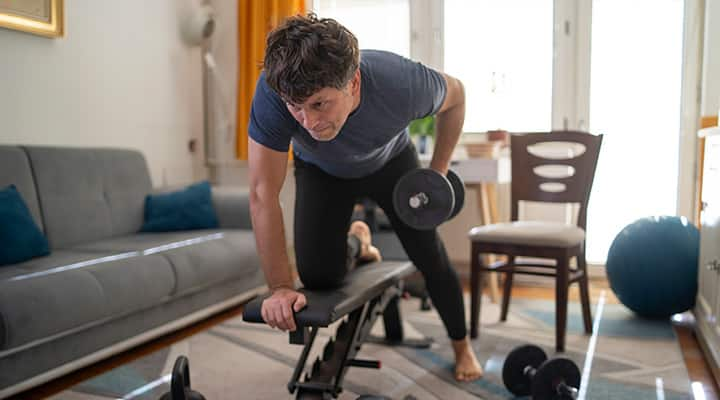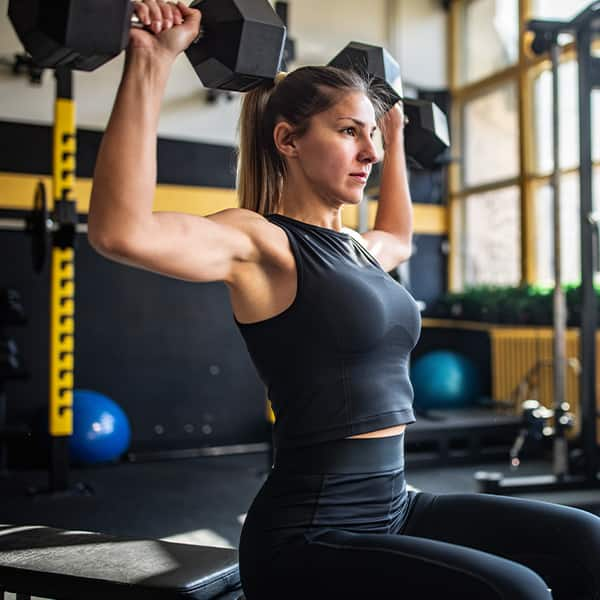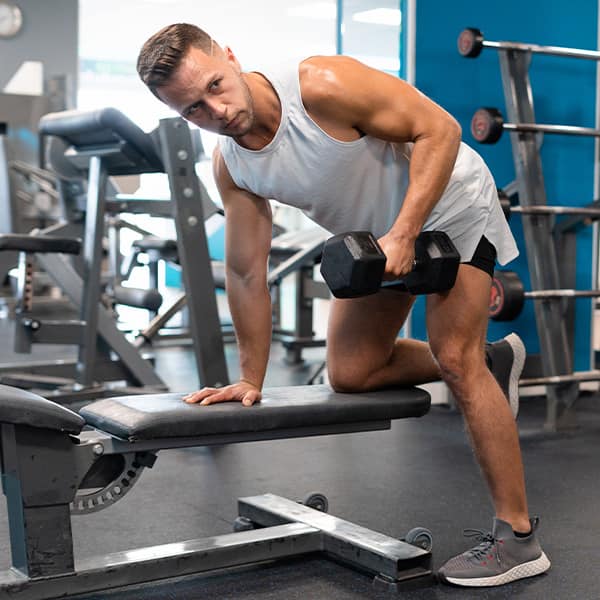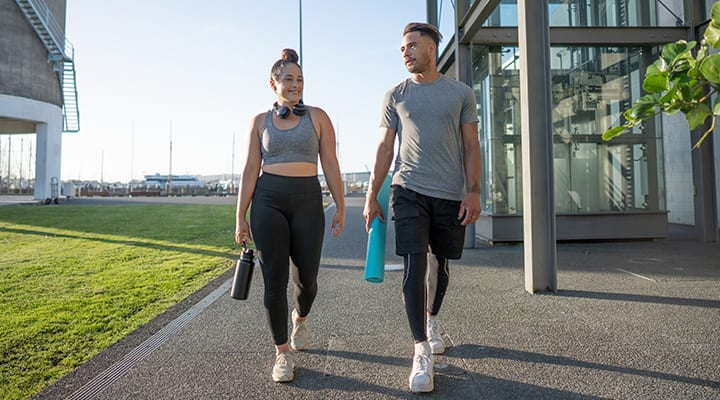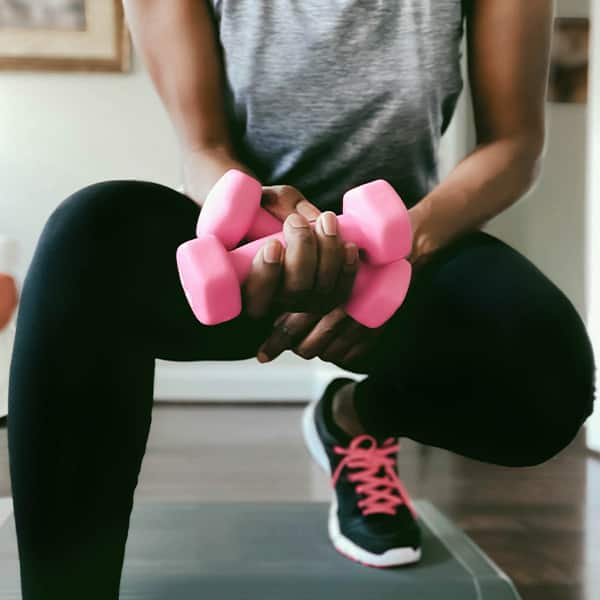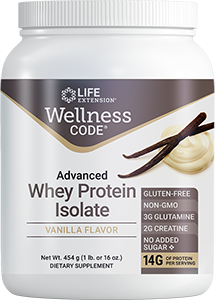
10 Best Back and Shoulder Dumbbell Workouts
Published: May 2025
Lat pulldowns, assisted pull-ups, landmine rows, cable reverse fly. There are plenty of good reasons to hit the gym for a back-and-shoulder workout. But do you really need all that equipment? Honestly, no.
You can absolutely build physical strength and muscle definition with an intense dumbbell workout that you can do at home or on the go. Choose from these 10 best back and shoulder dumbbell exercises, pair your workout with a creatine supplement, and you'll be well on your way to muscle gains!
Importance of training back and shoulders
All muscle groups deserve equal attention. But the back and shoulders do a lot of heavy lifting on a daily basis. By taking your back and arms through a dumbbell workout, you help build functional strength for everyday activities.
These muscles help you pick up your kids, carry groceries, unload the dishwasher, put luggage in an overhead compartment and so much more. Training the back and shoulders is also important for:
Good posture
—The back and shoulder muscles surround your spine, giving the spine the support it needs to stand upright. By strengthening these muscles, you increase your ability to stay upright longer and with good form.Athletic performance
—Strengthening the back and arms allows your body to move more efficiently in all planes of motion. This translates to greater athletic performance, whether you're throwing a baseball, swimming laps or biking down the street.Joint stability and comfort
—Creating stronger muscles surrounding a joint makes for a more stable joint. This is especially true for the shoulder muscles, as they are highly susceptible to instability.Muscle definition
—Those coveted cuts that define hard-working muscles don't come from resting. You have to consistently train your back and shoulders if you want well-defined arms or that V-tapered back.
Why use dumbbells?
Sure, you can use machines, barbells, resistance bands or even your own body weight (pull-ups for the win!) to strengthen your back and shoulders. But dumbbells are widely accessible. You can find a range of options—anywhere from one-pound weights to dumbbells weighing over 100 pounds.
Better yet, they don't take up much space in a home gym, and they're fairly easy to use, even for beginners. That said, advanced lifters will appreciate dumbbells for their functional versatility.
Unlike fixed-motion machines, dumbbells allow you to change body positioning in order to make an exercise harder. For instance, a low row becomes a lot more challenging when holding a plank and rowing from the ground.
But not all dumbbell exercises are created equal. Selecting the right dumbbell exercises will get you closer to seeing the results you're looking for.
Which dumbbell exercises strengthen my back and shoulders?
We've got some great exercises that target each of these muscle groups listed below! But a good rule of thumb for any type of strength training is to first identify exactly which muscles you're trying to target, and then pick the exercises that will strengthen them.
Your back muscles
: Consist of your latissimus dorsi (aka "lats"), rhomboids and erector spinae. The pull, row, hinge and isometric hold movement patterns target your back muscles.Your shoulder muscles
: Are made up of the anterior, lateral and posterior deltoids, the trapezius (aka "traps") and your rotator cuff muscles (supraspinatus, infraspinatus, teres minor, subscapularis). The movement patterns you should target for your shoulders are the press/push, pull, rotation and elevation.
Now that you know what you're focusing on, let's get into the exercises that can benefit these muscles the most.
Best shoulder exercises with dumbbells
1. Dumbbell Arnold press
The Arnold press is a cult favorite, because it was created by none other than Arnold Schwarzenegger—the "Terminator" himself, so you know it's a shoulder scorcher. The key is starting with palms facing your chin, and then rotating your palms away as you press your arms overhead.
The fluid rotation works all three heads of the deltoid muscles, plus the biceps and triceps. You can perform the Arnold press seated or standing. Standing will give you more leverage from your legs, but you'll get more back support staying seated.
2. Standing dumbbell front raise
Stand with a dumbbell in each hand, palms facing your legs and core braced for back support. As you lift your arms straight out in front of you, keep the core tight. Try to raise the dumbbells up to shoulder height, or as high as your mobility allows. You'll feel this primarily in the anterior deltoids. These are smaller muscles in the arms, which means you don't need a heavy weight to feel the burn.
3. Side plank dumbbell lateral raise
Start on the ground, lying on one side with arms, hips and feet stacked over each other. Actively press the forearm into the ground. With the dumbbell in your top hand, raise your arm straight up until it's perpendicular to the floor. You'll test the stability of the shoulder on the ground, while strengthening and defining the deltoids in the arms. Make this exercise easier by staggering your feet or dropping the bottom knee to the ground.4. Dumbbell upright row
While the upright row targets the upper back muscles, it also effectively builds strength in the deltoids and traps. With palms facing your body, pull the dumbbells straight up your torso, as if zipping up a jacket. To get more of the traps involved, hold the dumbbells slightly past shoulder width.
5. Bent-over dumbbell reverse fly
To isolate the posterior deltoids in your arms, try the bent-over reverse fly. When bent over, your chest should be parallel to the floor. From there, raise your arms up until in line with your head. Actively squeeze your shoulder blades together and hold the top of the exercise before slowly lowering back down.
Best back exercises with dumbbells
1. Bench single-arm dumbbell low row
Using a bench for support allows you to pull a heavier dumbbell. Place your right hand and right knee on the bench. The left foot is planted on the ground and the left arm has the dumbbell. From a bent-over position, pull the dumbbell toward your left hip. The low row gets its name from the hand positioning. So, be sure to use a neutral grip, with palms facing each other and elbows close to the body.
2. Single-arm dumbbell snatch
This is a compound movement that works multiple muscle groups at once. Plus, the explosiveness builds power to help you maintain fitness for life. Set yourself up with the dumbbell between your feet and feet hip-distance apart. Bend your knees to grab the weight, but don't go into a full squat. When you come up, keep the arms straight until your hips are fully extended. At this point, shrug and pull the dumbbell up and overhead.
3. Bent-over dumbbell high row
The high row requires that your palms face toward your body, which means elbows go out wide to the side as you pull the dumbbells up toward your chest. You'll feel this in your lats, rhomboids, traps and even posterior delts. The bent-over position will also light up your hamstrings.
Explore Our Best Active Lifestyle & Fitness Supplements
4. Dumbbell pullover
Start lying with your back on a bench and feet firmly on the ground. Hold a dumbbell over your chest, gripping from the inside of one end. Inhale as you lower the weight behind your head, keeping the arms straight. Do not completely lock out your elbows. Exhale as you pull the weight back to your chest. The dumbbell pullover targets both the back and chest muscles. To hit the lats more, let your elbows flare out to the side.
5. Conventional dumbbell deadlift
Best known as a leg exercise, the deadlift is actually a great way to train the erector spinae and lats. The best part? You can go really heavy with this one. Unlike a Romanian deadlift, you'll start this exercise from the ground—or close to it. The dumbbells should be on the outside of your feet, hips sitting back and shoulders over your knees. Keep your heels down, as you shift hips forward and stand up.Can you build a strong back and shoulders using only dumbbells?
Yes, it is possible to build a strong back and shoulders with just dumbbell exercises. In fact, a systematic review published in the Journal of Sports Medicine and Physical Fitness compared the use of free-weight dumbbells to machine-based training. Turns out, they elicited similar strength gains, along with similar improvements in power and muscle hypertrophy.
How Should I Break Up My Training Days?
It is possible to have too much of a good thing. In other words, be careful not to overtrain your back and arms with one dumbbell workout after another. Your body needs ample rest between training days. Typically, a split training routine is preferred, which involves breaking up the muscle groups. A split training routine may look like this:
- Monday: Back and shoulders
- Tuesday: Legs
- Wednesday: Rest
- Thursday: Chest and core
- Friday: Rest
- Saturday: Biceps and triceps
- Sunday: Legs
Within your back and arms day, choose the appropriate number of exercises, sets and reps. The research says that a typical strength and hypertrophy program for untrained or intermediately trained healthy adults should involve breaking down all major muscle groups.
More specifically, the sweet spot for training is around 2–4 sets of 8–10 exercises for 3–12 repetitions. You should also account for 2–5 min rest between sets. Do this 2–4 times per week and you should start to feel those muscle gains.
What weight should beginners start with for back and shoulder exercises?
If you're new to strength training, there is absolutely no shame in starting light. In fact, a perfectly good strategy is to use light weights for a high rep, especially when working the arms or doing any overhead press movement.
For example, pick up a five-pound dumbbell and knock out 12-20 reps. As you build strength, gradually increase the weight selection and lower the rep count. No matter which dumbbell weights you choose, keep performing reps until you reach failure. Once you can no longer maintain good form or move the dumbbell in a full range of motion, stop the exercise and rest.
Most importantly, listen to your body after each and every set. Temporary discomfort is normal, especially if you're working to the point of fatigue. Any prolonged or intense discomfort during a dumbbell workout is not normal.
Take those feelings as a sign you need to choose a lighter dumbbell, rest or end the workout completely. If you're really not sure where to start, enlist the help of a personal trainer, sports coach or other fitness professional you trust. These experts have the knowledge and skill sets to keep you safe during a dumbbell workout.
Common mistakes and safety tips
Here are the best practices for the best back and shoulder dumbbell workout:
Warm up and cool down—
No matter how long or how intense your workout is going to be, allot yourself a few minutes to warm up and a few minutes to cool down. Orthopedic experts explain that stretching the muscles after strength training helps restore range of motion in your back and arms and relieves occasional muscle soreness.Progressively overload—
The key word is "progressive," meaning take your time advancing your workouts or picking up a heavy dumbbell. Gradually increase the weight selection every week or every other week. When done correctly, progressive overload ensures you safely and effectively build muscle mass in your back and arms.Focus on form first and foremost—
Good form allows you to get the most out of each dumbbell exercise and ensures you are performing the exercise safely. Before you press or pull more weights, make sure your form is on point.Supplement for gains—
Extensive research has found that combining a fitness supplements like creatine with strength training can support upper body strength. Of course, creatine isn't the only important nutrient for muscle gain. Getting adequate protein from a healthy diet or supplementing with various amino acids, such as L-carnitine, can help promote cellular energy and recovery.
Not sure what else you need? Take our two-minute quiz to find out what other supplements can help you reach your specific health and fitness goals.
References
- Chaabene H, et al. "Acute Effects of Static Stretching on Muscle Strength and Power: An Attempt to Clarify Previous Caveats." Front Physiol. November 2019. https://pubmed.ncbi.nlm.nih.gov/31849713/
- Heidel KA, et al. "Machines and free weight exercises: a systematic review and meta-analysis comparing changes in muscle size, strength, and power." J Sports Med Phys Fitness. August 2022. https://pubmed.ncbi.nlm.nih.gov/34609100/
- Iversen VM, et al. "No Time to Lift? Designing Time-Efficient Training Programs for Strength and Hypertrophy: A Narrative Review." Sports Med. June 2021. https://pmc.ncbi.nlm.nih.gov/articles/PMC8449772/
- Restivo J. "Effective exercises for building a strong back." Harvard Health Publishing. February 2024. https://www.health.harvard.edu/exercise-and-fitness/effective-exercises-for-building-a-strong-back
- Wang Z, et al. "Effects of Creatine Supplementation and Resistance Training on Muscle Strength Gains in Adults <50 Years of Age: A Systematic Review and Meta-Analysis." Nutrients. October 2024. https://pubmed.ncbi.nlm.nih.gov/39519498/
- "Rotator Cuff and Shoulder Conditioning Program." American Academy of Orthopaedic Surgeons. June 2022. https://orthoinfo.aaos.org/en/recovery/rotator-cuff-and-shoulder-conditioning-program/
Always be in the know!
Access the latest deals, wellness news, expert health tips & more!



